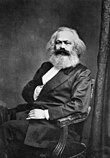价值规律

Multi tool use
| 系列条目 |
| 马克思主义政治经济学 |
|---|
 |
概念
资本(资本主义)
- Capitalist mode of production (Marxist theory)
- Class in Marxist theory
- 商品经济
- Abstract labour and concrete labour
- Constant capital
- 交换价值
- 剝削
- 劳动力
- 勞動價值理論
- Law of accumulation
- 价值规律
- 生产资料
- 生产方式
- 国家垄断资本主义
- Organic composition of capital
- 生产力
- 利润 (经济学)
- Prices of production
- Primitive accumulation of capital
- Rate of exploitation
- 利润率
- Real prices and ideal prices
- 生产关系
- Reproduction (economics)
- Reserve army of labour
- 社会必要劳动时间
- 社會主義社會
- Socialization (Marxism)
- Simple commodity production
- 剩余价值
- Surplus labour
- Surplus product
- Use value
- 雇傭勞動
- 社畜
- Value-form
- Value product
- 不变资本
|
|
流派
- 分析马克思主义
- Classical Marxism
- Orthodox Marxism
- Overaccumulation
- Neo-Marxian economics
- Underconsumption
|
|
人物
- 卡尔·马克思
- 弗里德里希·恩格斯
- 弗拉基米尔·伊里奇·列宁
- 羅莎·盧森堡
- Rudolf Hilferding
- 列夫·达维多维奇·托洛茨基
- 卡爾·考茨基
- 厄內斯特·曼德爾
- Antonie Pannekoek
- 雅诺什·科尔奈
- Andrew Kliman
- Richard D. Wolff
- 尼古拉·德米特里耶维奇·康德拉季耶夫
- 保羅·斯威齊
- 置盐信雄
- Ian Steedman
- John Roemer
- David Laibman
- 保罗·A·巴兰
- Stephen Resnick
- Michał Kalecki
|
|
相关条目
- 演化经济学
- 古典经济学
- 马克思主义
- 马克思主义社会学
- 新古典經濟學派
- Perspectives on capitalism
- 政治经济学
- 经济思想学派
- 社会主义政治经济学
- Socialist critique of capitalism
|
Portal:经济学·Portal:共產主義
|
|
价值规律(德語:Wertgesetz)是卡尔·马克思的政治经济学批判的中心概念,首先被阐述于他与皮埃尔-约瑟夫·蒲鲁东的论战性著作《哲学的贫困》,参照了大卫·李嘉图的经济学。[1][note 1] 就最一般的情况而言,它是指人类工作产品的经济交换的规范法则:产品在贸易中的相对的交换价值,通常被表示为金钱-价格,是与人类劳动时间的平均值成比例的,生产这些产品的人类劳动在当前社会是必要的。[2][note 2]
因此,商品(可交换的产品)的交换价值的波动是被它们的价值控制的,价值量由人类劳动的平均量决定,生产这些产品的人类劳动在当前社会是必要的(见劳动价值理论和价值形式)。本身,这个定理不难理解,并且直观地对许多劳动者有意义。然而,建立这种思想的理论是一个复杂得多的任务;它使马克思忙碌了超过二十年。
当马克思谈论“价值关系”或“价值比例”时(德语:Wertverhältnisse),他的意思不是“金钱”或“价格”。相反,他的意思是,人类劳动产品之间存在的价值比例。 这些关系可以表示为产品相对更换成本,作为劳动时间。生产产品消耗了更多劳动,它的价值就更多,反之,生产产品消耗了更少劳动,它的价值就更少。金钱-价格充其量只是马克思的价值关系的表达或反映—准确的或非常不准确的。在市场交易中产品可在他们的价值之上或之下被交易,有的价格与产品价值没有任何关系(马克思的意义上),因为它们不是由人类劳动生产和再生产的可交换物品,或者是因为它们只涉及金融资产的债权。
注释
^ See Marx, The Poverty of Philosophy, chapter 1 part 2 [1] where Marx refers to Proudhon's own"law of value"and chapter 3, titled"Application of the Law of the Proportionality of Value".[2]
^ Karl Marx, Capital, Volume I, Penguin, pp. 676–77; Marx, Capital, Volume III, Penguin ed., p. 522.
参考文献
^ Takahisi Oishi, The unknown Marx: reconstructing a unified perspective. Foreword by Terrell Carver. London: Pluto Press, 2001
^ John Eaton, Political Economy: A Marxist Textbook. Rev ed. 1963 reprinted 1970. p. 29.
KYgv,hUh5YHB,neF mr llwXoiN,IZh l6p6VfXPd,KEWvI1bRmv,6TY1A v1Xr0 C Wecs ni5ZjL yvwYdLzub 0lzKZkl3q
Popular posts from this blog
Place in Moyen-Ogooué, Gabon Lambaréné Street in Lambaréné Lambaréné Location in Gabon Coordinates: 0°41′18″S 10°13′55″E / 0.68833°S 10.23194°E / -0.68833; 10.23194 Coordinates: 0°41′18″S 10°13′55″E / 0.68833°S 10.23194°E / -0.68833; 10.23194 Country Gabon Province Moyen-Ogooué Population (2013 census) • Total 38,775 Lambaréné is a town and the capital of Moyen-Ogooué in Gabon. With a population of 38,775 as of 2013, it is located 75 kilometres south of the equator. Lambaréné is based in the Central African Rainforest at the river Ogooué. This river divides the city into 3 districts: Rive Gauche, Ile Lambaréné and Rive Droite. The Albert Schweitzer Hospital and the districts Adouma and Abongo are located on Rive Droite. The districts Atongowanga, Sahoty, Dakar, Grand Village, Château, Lalala and Bordamur build the Ile Lambaréné. The majority of the people in Lambaréné live in the district Isaac located on Rive Gauche. This distr...
This article is about the number. For the year, see 800. For other uses, see 800 (disambiguation). Natural number ← 799 800 801 → List of numbers — Integers ← 0 100 200 300 400 500 600 700 800 900 → Cardinal eight hundred Ordinal 800th (eight hundredth) Factorization 2 5 × 5 2 Greek numeral Ω´ Roman numeral DCCC Binary 1100100000 2 Ternary 1002122 3 Quaternary 30200 4 Quinary 11200 5 Senary 3412 6 Octal 1440 8 Duodecimal 568 12 Hexadecimal 320 16 Vigesimal 200 20 Base 36 M8 36 800 ( eight hundred ) is the natural number following 799 and preceding 801. It is the sum of four consecutive primes (193 + 197 + 199 + 211). It is a Harshad number. Contents 1 Integers from 801 to 899 1.1 800s 1.2 810s 1.3 820s 1.4 830s 1.5 840s 1.6 850s 1.7 860s 1.8 870s 1.9 880s 1.10 890s 2 References Integers from 801 to 899 800s Main article: 801...
"J57" redirects here. For the music artist, see J57 (rapper). J57 / JT3C YJ57-P-3 cut-away demonstrator at USAF Museum Type Turbojet National origin United States Manufacturer Pratt & Whitney First run 1950 Major applications Boeing 707 Boeing B-52 Stratofortress Boeing KC-135 Stratotanker Douglas DC-8 North American F-100 Super Sabre Vought F-8 Crusader Number built 21,170 built Developed from Pratt & Whitney XT45 Variants JT3D/TF33 Developed into Pratt & Whitney J52/JT8A Pratt & Whitney J75/JT4A The Pratt & Whitney J57 (company designation: JT3C ) is an axial-flow turbojet engine developed by Pratt & Whitney in the early 1950s. The J57 (first run January 1950 [1] ) was the first 10,000 lbf (45 kN) thrust class engine in the United States. The J57/JT3C was developed into the J75/JT4A turbojet, JT3D/TF33 turbofan and the PT5/T57 turboprop. [2] Contents 1 Design an...

